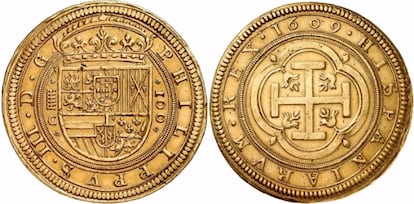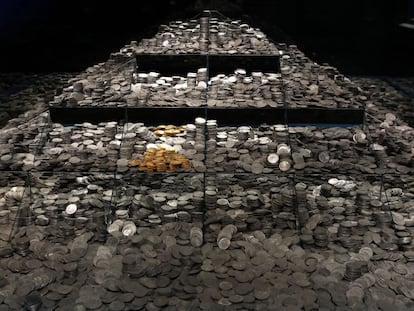The most valuable Spanish coins in history
Expert Jesús Losada has written a book about the pieces that have racked up the highest prices at auction, including one unique item that was sold for €944,000


At noon on October 22, 2009, the main hall at the Hotel Arts in Barcelona was filled to capacity. There had been more than 1,200 requests to attend the event, but only 200 people had been selected to witness the auction house Áureo & Calicó offer collectors from across the world a chance to buy a gold coin made in Segovia in 1609, under the reign of Philip III of Spain. The piece was denominated in escudos – a currency used until the early 19th century – and was part of the Caballero de Yndias collection, a compendium of over 2,000 coins that once belonged to a Spaniard who had settled down in Cuba.
The starting price for this unique item – measuring 71 millimeters and weighing 339 grams – was €800,000 and that was without factoring in an additional 18% in fees. Only one individual at the auction, a Swiss man identified simply as Number 74, rose to the challenge: he paid €944,000 for the 100-escudo piece, making it the most valuable coin in Spanish history.
The Spanish government, then led by Prime Minister José Luis Rodríguez Zapatero of the Socialist Party (PSOE), was unable to exercise preferential acquisition rights because the coin had been “a temporary import,” meaning that it had been brought to Spain from abroad exclusively to be sold at the auction.
“A coin is worth precisely what someone is willing to pay for it at any given moment, but as an investment, it is not safe. It is ruled by the laws of supply and demand to a superlative degree,” notes the expert Jesús Losada in his book Las monedas españolas más valiosas (or, The Most Valuable Spanish Coins), which explores the biggest global auctions to 2021 involving these sought-after objects.

In his book, Losada explains that the coin purchased by the unknown Swiss collector was originally made at the Royal Mint of Segovia, the only facility with the necessary machines to craft it. Doing so involved inserting sheets of gold “through two cylinders that were activated by a large hydraulic wheel as many times as necessary, until a sheet of the required thickness was achieved.” This thinner sheet would then pass through two other cylinders to strike both sides of the coin with the appropriate design. There are only seven other known facilities in the world with this kind of machinery.
The second-most-valuable Spanish coin ever sold at auction was minted in Pamplona in 1652 during the reign of Philip IV. It is an eight-escudo piece that once belonged to the collection of Archer Huntington, a 19th-century philanthropist from New York who donated it to the Hispanic Society of America. When the museum found itself in dire financial straits, it was forced to sell off its 38,000-strong collection. The sale took place at Sotheby’s in March 2012 and raised $30 million (€26 million). The Spanish coin was bought for €614,250 and auctioned off again in November of that year.
As for the third most valuable Spanish coin ever sold at auction – another 100-escudo piece made in 1633 under Philip IV – only four of them are known to exist: one is kept at Spain’s National Archaeology Museum, another one belonged to the Prince of Ligne (a Belgian lineage) who sold it in London in 1968, and a third was in the hands of a collector from Milan known only as L. B. who auctioned it off in 2019 for €590,000.
On July 31, 1715, a large fleet of Spanish galleons laden with riches sank off the coast of Florida after departing from Havana on its way to Spain. A hurricane destroyed 11 out of the 12 ships, and more than 100,000 coins ended up at the bottom of the Atlantic Ocean. Thousands of them have since been found by treasure hunters who offer them to auction houses, even though legally they belong to the Spanish state because they were part of a shipment on state-owned vessels. One of these coins went on sale in 2009. Minted in Mexico in 1695, under the reign of Charles II, the buyer paid €448,000 for the eight-escudo gold piece.

But not all the most valuable coins sold at auction are made of gold. The seventh spot is held by a silver eight-real coin minted in 1538 in Mexico during the reign of Queen Joanna I. It was sold by the auction house Daniel Frank Sedwick for €469,400 in November 2014, thus becoming the most expensive Spanish silver coin in history. This coin was legal tender in the United States until 1857, “which means these eight-real coins were the true first dollars” in America, according to Losada. Two more such coins are known of, both of which were plucked out of shipwrecks.
Losada also notes that there are other old coins that have never been auctioned off, making it hard to know their market value, but which he estimates at above €1 million. He mentions 50 examples from the days of the Catholic monarchs in the late 15th and early 16th centuries, including “a real gem weighing 176 grams with a diameter of 66 millimeters, minted in Seville between 1497 and 1504.” Until 2012, this too belonged to the Hispanic Society of America in New York.
The Cortes de Monzón, an early parliamentary body, gave Charles I of Aragón “the biggest coin of all time,” a 100-ducat piece weighing 349 grams with a diameter of 83 millimeters. It was a thank-you gift for getting behind the construction of the Imperial Canal of Aragón, a project to divert water from the Ebro River to feed the farmland in what is today Zaragoza. The coin shows the faces of Joanna I and her son Charles with the legend in Latin “Iona et Karolus reges aragorum trunfatores et katolicis” (or, Joanna and Charles monarchs of Aragón triumphant and Catholic). During the Spanish War of Independence against Napoleon, it was stolen by the latter’s troops and is now on display in Paris, at the National Library.
Losada’s favorite, however, appears to be a large coin made under Ferdinand IV of Castile, “an impressive and unique” gold coin weighing 45 grams with a diameter of 67 millimeters, which is undated but believed to have been made between 1304 and 1308. This coin is now at the Valencian Institute of Don Juan in Madrid.
Losada seems surprised that no Spanish coins, despite their rarity, technical quality and good state of conservation, have ever reached a selling price of $1 million (€880,000) at auction, whether in Spain or abroad. The most expensive coin ever sold is a double eagle, a gold coin made in the United States in 1933, with a denomination of $20 (€18). This past June, a collector paid €15.4 million for it even though there are 12 others just like it. “But that’s a whole other story,” says Losada.
Tu suscripción se está usando en otro dispositivo
¿Quieres añadir otro usuario a tu suscripción?
Si continúas leyendo en este dispositivo, no se podrá leer en el otro.
FlechaTu suscripción se está usando en otro dispositivo y solo puedes acceder a EL PAÍS desde un dispositivo a la vez.
Si quieres compartir tu cuenta, cambia tu suscripción a la modalidad Premium, así podrás añadir otro usuario. Cada uno accederá con su propia cuenta de email, lo que os permitirá personalizar vuestra experiencia en EL PAÍS.
¿Tienes una suscripción de empresa? Accede aquí para contratar más cuentas.
En el caso de no saber quién está usando tu cuenta, te recomendamos cambiar tu contraseña aquí.
Si decides continuar compartiendo tu cuenta, este mensaje se mostrará en tu dispositivo y en el de la otra persona que está usando tu cuenta de forma indefinida, afectando a tu experiencia de lectura. Puedes consultar aquí los términos y condiciones de la suscripción digital.
More information
Últimas noticias
How Japan is trying to avert ‘digital defeat’
From digital curfews to blocking apps: How technology experts protect their children online
Why the price of coffee has skyrocketed: from Brazilian plantations to specialty coffee houses
Confined to a Cuban hospital: When electricity is a matter of life or death
Most viewed
- Pablo Escobar’s hippos: A serious environmental problem, 40 years on
- Reinhard Genzel, Nobel laureate in physics: ‘One-minute videos will never give you the truth’
- Why we lost the habit of sleeping in two segments and how that changed our sense of time
- Charles Dubouloz, mountaineering star, retires at 36 with a farewell tour inspired by Walter Bonatti
- The Florida Keys tourist paradise is besieged by immigration agents: ‘We’ve never seen anything like this’










































